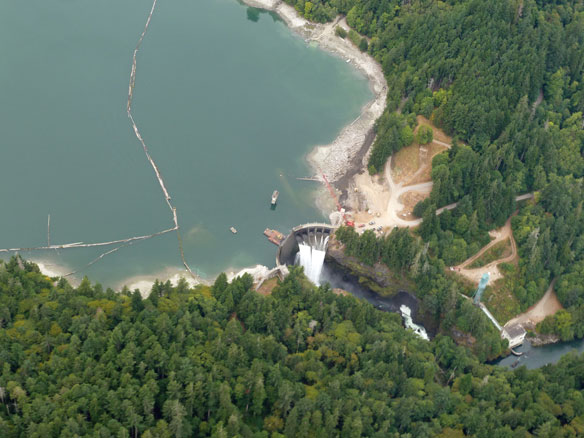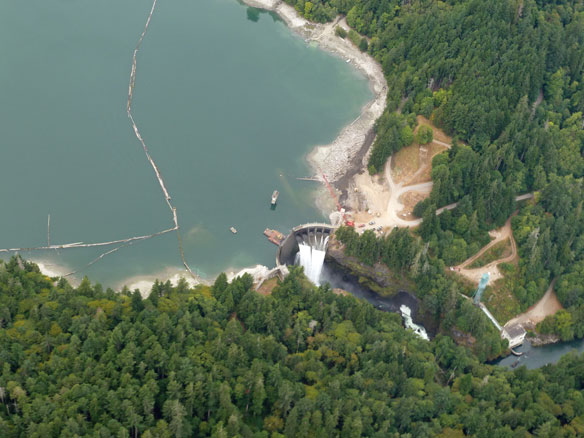
Elwha Dam removal, 2011. The largest dam-removal project in U.S. history—the Elwha River Restoration Project—commenced during the second week of September 2011, when National Park Service contractors began to dismantle two dams on the Elwha River in Washington State. The 32-m-tall Elwha Dam and the 64-m-tall Glines Canyon Dam, completed in 1913 and 1927, respectively, have been blocking the natural supply of sediment to the lower river and coast and severely limiting salmon and steelhead spawning for nearly a century. Captions: Jonathan A. Warrick / USGS. Photograph: © SAF – Coastal Care.
Excerpts;
Vast amounts of river-borne sediment are trapped behind the world’s large dams, depriving areas downstream of material that is badly needed to build up the marshes and wetlands that act as a buffer against rising seas.
Scientists are now beginning to fully appreciate the life-giving effects of sediment, which some researchers. Now, as global warming steadily melts glaciers and polar ice sheets, quickening the pace of sea level rise, scientists say that a severe shortage of river-borne sediment — most of it trapped behind dams — will increasingly be felt along the world’s coasts…
Read Full Article, Yale E360 (06-20-2017)
Elwha, The Grand Experiment (11-12-2012)
Sediment Trapped Behind Dams Makes Them ‘Hot Spots’ for Greenhouse Gas Emissions (08-2013)
Taking Down Dams and Letting the Fish Flow, The New York Times (10-24-2016)
Nationwide, dam removals are gaining traction. Four dams are slated for removal from the Klamath River alone in California and Oregon by 2020. And the lessons are the same everywhere: Unplug the rivers, and the fish will return…
“River Reborn: Elwha Flows Wild and Free Once Again,” NBC News
A construction crew on Tuesday detonated a large charge of dynamite, destroying the last remaining portion of Glines Canyon Dam and hastening the restoration of the Elwha River in the far reaches of the Pacific Northwest.
1000 Dams Down and Counting: Dam Removal Study Reveals River Resiliency, USGS (05-02-2015)
More than 1,000 dams have been removed across the United States because of safety concerns, sediment buildup, inefficiency or having otherwise outlived usefulness. A paper published in Science Magazine finds that rivers are resilient and respond relatively quickly after a dam is removed…
Undamming Rivers: A Chance For New Clean Energy Source; Yale E360 (08-07-2015)
Hydroelectric power is often touted as clean energy, but this claim is true only in the narrow sense of not causing air pollution. In many places, such as the U.S. East Coast, hydroelectric dams have damaged the ecological integrity of nearly every major river…
The Wrong Climate for Damming Rivers, A Video from Todd Southgate (05-26-2016)
Though large hydropower projects are often presented as a “clean and green” source of energy, nothing could be further from the truth…
Mega Dams Remain Controversial Source of Energy; IPS News (06-09-2016)
Dams – Cutting off our Beach Sand; By Gary Griggs (12-19-2014)
Let’s Talk About Sand: “Sand Wars” Film Director Denis Delestrac, At TEDxBarcelona (©-2013)









